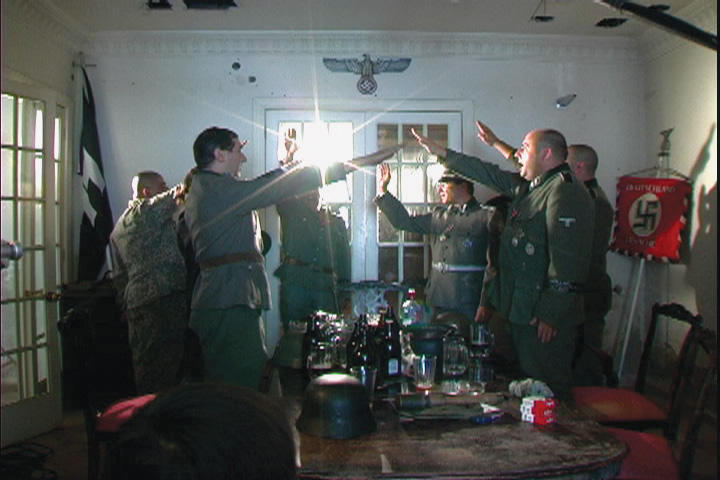
What could possibly bring together a lineup of talk show aficionados, a barbarian/urban setting, and a group of Third Reich devotees? Sounds like creative twenty-first century portraiture, a sort of contemporary human comedy. But this mordant cast — usually comprising the very individuals the work is meant to represent — inhabits artist Yoshua Okon’s videos, photographs, and installations, raising questions as to the very possibility of any objective representation.
In his practice, Okon engages in a close collaboration with his subject-actors — mostly ordinary people leading ordinary lives — underscoring the fact that we represent ourselves as open constructs on a daily basis. His videos and installations are thus located somewhere between staged reality and everyday fiction, seeking to dislocate existing social types and the cultural archetypes they continuously re-enact.
The cultivated complicity that characterizes Okon’s work — that is, his subjects’ total awareness of being filmed — frequently raises moral and ethical questions, especially when it comes to how class and identity are disclosed within different social milieus. In early works such as Oríllese a la orilla (1999–2000), a series of videos epitomizing the corrupt policeman; Cock Fight (1998), a double-life-size projection typifying misbehaving school girls; or Rinoplastía (2000), a feature-length video illustrating one day in the life of a rich kid, Okon’s work exerts a voyeuristic manipulation of the camera that simultaneously relies on the spontaneous exhibitionism of his improvised actors. In New Décor (2002), Okon invited passersby to perform everyday situations in a middle-class Los Angeles furniture store that was turned into a video set. As he expected, the unscripted scenes ended up being a sort of cathartic enactment of self-made fantasies based on soap opera-like scenarios, actively exposing the mechanisms and conventions that so often shape our behaviors and perceptions.
While in the latter case the actors’ desires and delusions placed the work somewhere between the narrative feature and the documentary, turning its protagonists into socially vulnerable subjects, in other cases it is the viewer’s expectations that seem to be mediated by the artifice of the camera, as in Lago Bolsena (2005). The piece features a community living in an ill-reputed Mexican neighborhood that plays itself as a group of savages caught by the artist’s feigned “ethnographic gaze.” Rather than chronicling the community’s way of life as culturally, racially, or socially divergent from Western norms, the pseudoscientific perspective adopted by Okon aimed at symbolizing the prejudices through which this community is usually perceived.
Okon is currently completing the final edit of Boca Negra, a video installation for which he collaborated with a group of Third Reich enthusiasts who sell all sorts of Nazi memorabilia in one of Mexico City’s main flea markets. The artist asked them to dress up in their uniforms and march in one of the city’s 1930s European neighborhoods. Despite all the ceremoniousness displayed by the actors — being guided in their parade by a real military person holding a black SS flag and counting the measure in German — viewers can detect a series of mismatches, such as Brazilian music that happened to be playing in the streets while the video was being filmed, the racial variety of the occasional passersby, the decidedly un-Germanic presence of palm trees.
With Boca Negra, Okon not only aims to deceive our expectations regarding an empty mise en scène that stands for an ahistorical reenactment, but he also confronts us with the multiple resonances of the actors’ passionate political fetishism. While this first component of the work will be played on five plasma screens in order to create a pentagon shape meant to surround the viewer, the piece’s second component will feature some sort of behind-the-scenes projection, in which the marchers, still dressed up in their costumes, share some drinks and discuss their take on the importance and meaning of National Socialism today. For some of them, it’s a personal ideology whose uprightness affects one’s country’s political and economic well-being; for others, its principles are more about vindicating xenophobic nationalism rather than asserting racial superiority (one wonders how it could be otherwise, Mexico being a racially mixed and fragmented country — although one of the marchers suspiciously maintains that the Aztecs were Aryans, since they never mixed with other races).
As the conversation evolves among cameras, lights, and boom operators — which the actors take as witnesses to the seriousness of their propositions — the heated discussion gets more and more personal until one of the characters says, irritated, that he isn’t acting anymore. As if he ever was. Here again, the escalating tension emanates from the factual documentation of what first started as a staged situation, turning National Socialism into a somewhat historical construction that these dressed-up characters lightly call a metaphore.
By revealing that National Socialism as understood here is not too distant from recently awakened forms of nationalism and patriotism around the world, Boca Negra, like many of Okon’s previous works, will raise questions as to the conditions under which these cultural and ideological migrations occur and tend to develop lives of their own. After seeing the raw footage that will make up the piece, we’re left wondering if we’ve been witness to a tragically absurd historical re-enactment or, rather, to a serious confusion of place and time.